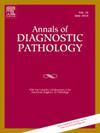Metastases from uveal melanoma may lack S100 expression: A clinico-pathologic and immunohistochemical study with emphasis on potential causes and diagnostic implications
IF 1.4
4区 医学
Q3 PATHOLOGY
引用次数: 0
Abstract
Uveal melanoma (UM) is the most common primary intraocular malignancy in adults, with a high mortality rate due to metastasis, primarily to the liver. The differential diagnosis of metastatic UM, particularly in distinguishing it from cutaneous melanoma (CM), can be challenging due to overlapping histopathological features. This study investigates the immunohistochemical expression of S100 in a cohort of 41 cases, including 13 metastatic UMs, 18 metastatic CMs, and 10 primary UMs. Our results demonstrate a significant lack of S100 immunoreactivity in metastatic UM, with 84.6 % of cases showing negativity, in contrast to the diffuse positivity seen in both primary UM and metastatic CM. This finding suggests that the absence of S100 could serve as a useful marker to differentiate metastatic UM from CM, especially in cases where the primary tumor is unknown. Furthermore, the study highlights the potential diagnostic pitfall of relying solely on S100 expression on small biopsies. The absence of S100 in metastatic UM may reflect a shift in antigenic expression, possibly due to tumor dedifferentiation or clonal selection of S100-negative cells with a higher metastatic potential. Our findings emphasize the importance of employing a comprehensive immunohistochemical panel, including markers such as HMB45, SOX10, and Melan-A, in the accurate diagnosis of metastatic melanomas.
葡萄膜黑色素瘤的转移可能缺乏S100表达:一项强调潜在原因和诊断意义的临床病理和免疫组织化学研究
葡萄膜黑色素瘤(Uveal melanoma, UM)是成人最常见的原发性眼内恶性肿瘤,因转移而死亡率高,主要转移到肝脏。转移性UM的鉴别诊断,特别是将其与皮肤黑色素瘤(CM)区分开来,由于重叠的组织病理学特征,可能具有挑战性。本研究研究了S100在41例队列中的免疫组织化学表达,其中包括13例转移性UMs, 18例转移性CMs和10例原发性UMs。我们的研究结果表明,转移性UM明显缺乏S100免疫反应性,84.6%的病例呈阴性,而原发UM和转移性CM均呈弥漫性阳性。这一发现表明S100的缺失可以作为区分转移性UM和CM的有用标记物,特别是在原发肿瘤未知的情况下。此外,该研究强调了仅依靠小活检中S100表达的潜在诊断缺陷。转移性UM中S100的缺失可能反映了抗原表达的转变,这可能是由于肿瘤去分化或具有更高转移潜力的S100阴性细胞的克隆选择。我们的研究结果强调了在准确诊断转移性黑色素瘤时使用综合免疫组化小组的重要性,包括HMB45、SOX10和Melan-A等标记物。
本文章由计算机程序翻译,如有差异,请以英文原文为准。
求助全文
约1分钟内获得全文
求助全文
来源期刊
CiteScore
3.90
自引率
5.00%
发文量
149
审稿时长
26 days
期刊介绍:
A peer-reviewed journal devoted to the publication of articles dealing with traditional morphologic studies using standard diagnostic techniques and stressing clinicopathological correlations and scientific observation of relevance to the daily practice of pathology. Special features include pathologic-radiologic correlations and pathologic-cytologic correlations.

 求助内容:
求助内容: 应助结果提醒方式:
应助结果提醒方式:


